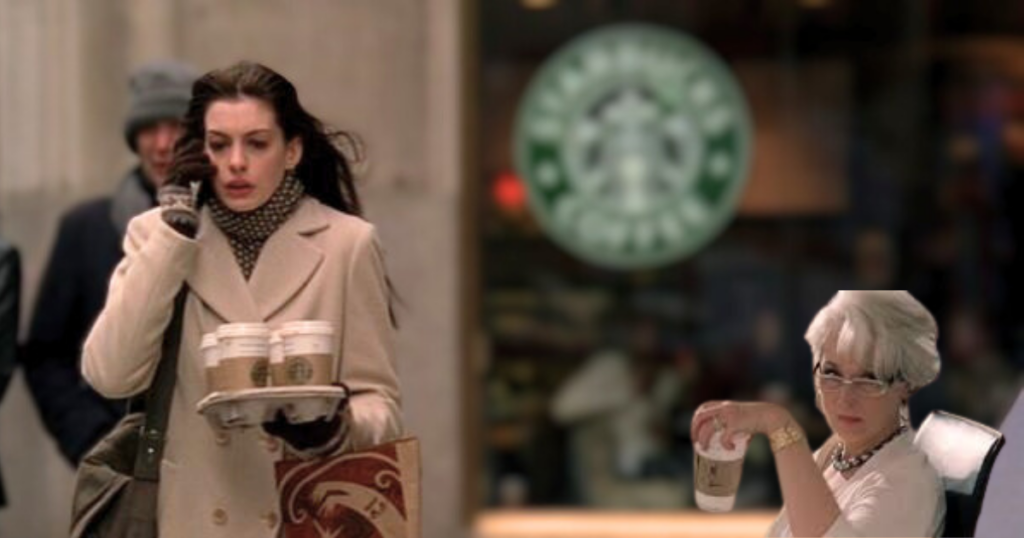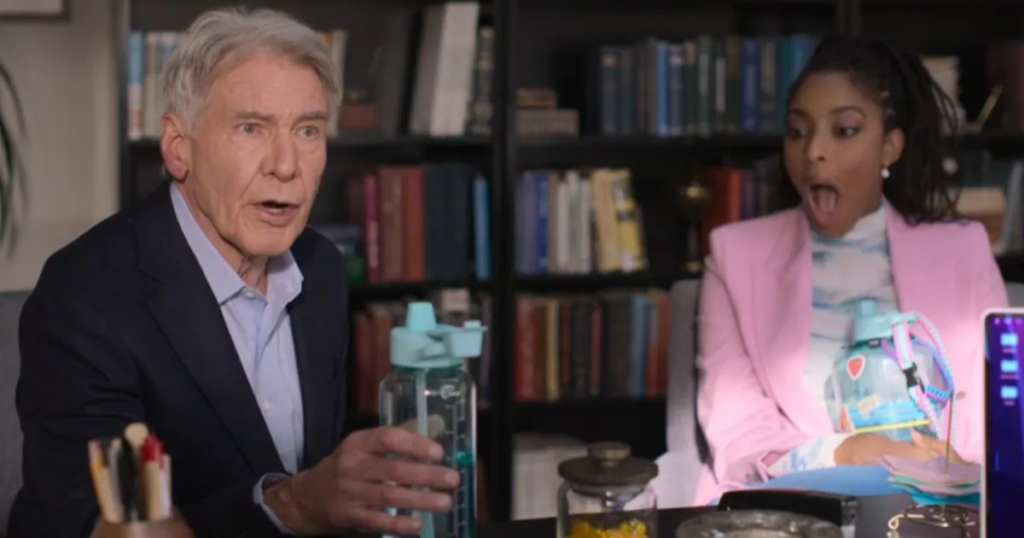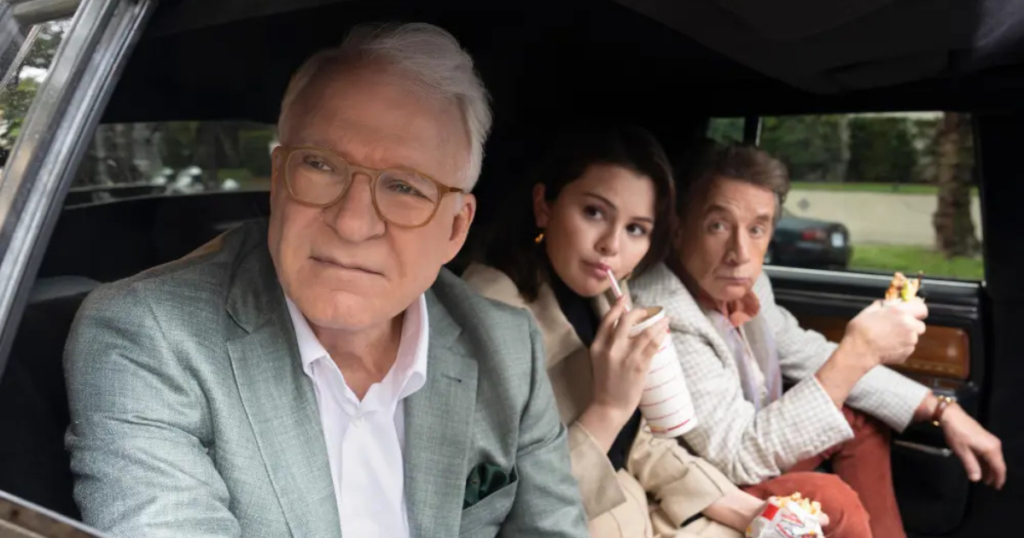What image comes to mind when you picture a successful, busy character in a TV show? For many, it’s someone striding into an office, mobile phone in one hand and a disposable coffee cup in the other. This image of success and power has been reinforced by decades of TV and film. Think of Miranda Priestly in The Devil Wears Prada: a high-powered woman whose assistant fetches her very specific coffee order every day in a single-use cup. This is just one example of how props function as symbols of character and status. A throwaway lifestyle signifies success, but is this the right message to be sending audiences? And in general, given what we now know about its impact, should single-use plastic be presented on screen as a positive – or even neutral – part of society?

Media’s role in normalising behaviour
“We are shaped and formed by what we watch”- Diana Cohen, Co-founder and CEO of the Plastic Pollution Coalition (PPC).
The media has the power to normalise or demonise behaviours. Characters become popular because people relate to them, idolise them and want to be like them. Take smoking: once a symbol of the “cool” character (e.g. Danny Zuko in Grease), its use on screen shifted with growing awareness of health impacts. Regulations limited its presence, and depictions changed. Broadly speaking, it became a symbol of weakness, struggle or villainy.
How is plastic portrayed on screen? A 2021 PPC study found that 93% of plastic shown in a sample of popular TV and films from 2019-2020 was not disposed of on screen. Of the 7% that was disposed of, 80% was littered. This gives the audience two messages:
- That plastic simply “disappears”.
- Irresponsible disposal, like littering, is acceptable.
Since then, knowledge about plastic’s impact on our planet, climate and health has grown massively and the public’s attitudes towards plastic have also shifted. It’s clear TV and film producers need to catch up. Let’s look at some recent popular TV shows and how they have, or haven’t, addressed single-use plastic.
Direct references to reuse culture
Hacks (2021-present) uses the age gap between young writer Ava and veteran comedian Deborah to discuss a variety of environmental issues. In early episodes, Ava chastises Deborah for always getting single-use plastic cups for fizzy drinks and persuades her to get a reusable cup instead. In “One Day” (season three, episode five), Deborah initially dismisses climate change: “the Earth is a billion years old. It just self-corrects from any damage that’s done to it…Trust me, we’re fine”. Ava gradually educates her, and in the closing scene, Deborah reprimands her makeup artists for using plastic. These conversations are not clunky or forced. As The Hollywood Reporter notes, the show seamlessly integrates “deeply felt activist stances” without sacrificing comedy.
Quietly sustainable: the power of visual cues

Of course, reuse doesn’t have to be talked about directly by the characters to have an impact. By simply showing reuse in action, Shrinking (2023 – present) and Abbott Elementary (2021- present) make it feel natural and commonplace. In Apple TV’s Shrinking, Gaby’s “emotional support water bottle” is a recurring feature, but its environmental impact is not explicitly mentioned. Instead, the characters discuss how hydrated Gaby is, and she uses it as a way to bond with one of her colleagues.
Planet-friendly behaviour is seen regularly in Disney’s Abbot Elementary. The teachers all have reusable coffee cups, the staff car share or walk to events, and there is a school garden project. While some single-use items are still present on screen, in general, sustainable choices are the default option without making any particular fuss about it. Having popular, likeable characters associated with reuse sends a powerful message to audiences.
In comparison, Only Murders in the Building (2021 – present), like most shows, missed an opportunity to show reuse as a standard option. The Disney show centres around a friendship between Charles and Oliver, in their 70s, and Mabel, in her early 30s. They frequently use disposable coffee cups and cutlery. Like in Hacks, the writers could have used the age gap to spark conversations about reuse. For example, Mabel could carry a reusable coffee cup while Oliver and Charles take single-use – the outdated option. Or they could have had characters of all ages using reusable cups and cutlery – normalising the behaviour across generations.

Perhaps in the future we might even see whole reuse systems in action in popular TV shows and movies?
Behind the scenes
Who can forget the famous Starbucks coffee cup left on set in Game of Thrones? The TV and film industry is known for waste. A typical 60-day shoot uses 39,000 single-use water bottles. On top of that, large quantities of disposable plastic plates, utensils and coffee cups are used every day on set. Quinta Brunson, creator, writer and star of Abbott Elementary, has been open about the need for change in the industry. She is leading by example, providing reusable water bottles for everyone on her set. Lucia Aniello, showrunner for Hacks, also supports sustainability. She worked with the studio to reduce waste by eliminating plastic water bottles on set and having characters repeat outfits. Changes we want to see on screen should be mirrored by changes off screen.
What needs to happen?
Given the well-documented health and environmental harms of plastics, the way they are portrayed on screen needs to be addressed. Producers should consider their depiction with the same responsibility now applied to tobacco and alcohol. If they acknowledged their duty it would undoubtedly help to make sustainable behaviours more mainstream. It would also reflect the attitudes of growing numbers in their audiences who are concerned about single-use plastics.
As viewers, we should be aware of how single-use plastic is portrayed on screen. The Begley-Cohen Test, developed by the PPC, encourages the critical evaluation of single-use plastic in the media.
To pass the test, the following criteria must be met:
- No single-use plastics appear on the screen
- If single-use plastic does appear on the screen, it is portrayed or discussed as problematic
Try it on the next thing you watch and share your findings! The stories we see on screen can be shaped by pressure from the people who watch them. Films and TV shows are both a reflection and an important driver of aspirations. And what better goal to have than a world free from plastic pollution?


Join the conversation